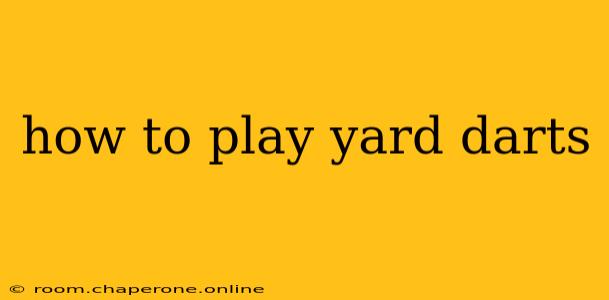Yard darts, also known as lawn darts or javelins, is a fun outdoor game perfect for all ages and skill levels. While seemingly simple, mastering the technique and strategy behind a successful game takes practice and understanding of the rules. This comprehensive guide will walk you through everything you need to know to play yard darts like a pro.
Getting Started: Equipment and Setup
Before you can start playing, you'll need the right equipment and a suitable playing area.
Essential Equipment:
- Yard Dart Set: These typically include four to six darts, with two distinct colors to differentiate between teams or players. Look for sets with sturdy construction and sharp, weighted tips for better accuracy and distance. Check the weight and length; some variations exist depending on the brand and intended age group.
- Target: While not strictly necessary, a designated target area improves gameplay and enhances the competitive element. You can use a simple circle marked on the ground, a designated spot on a lawn, or even purchase a dedicated yard dart target.
Setting Up the Game:
- Choose a Safe Playing Area: This is crucial, especially if children are playing. Ensure the area is clear of obstacles like trees, fences, or other people. A level grassy area is ideal, but a flat paved area works too.
- Establish the Throwing Line: Mark a throwing line with chalk or a rope. This will maintain consistency between throws and ensure fair play. The distance between the throwing line and the target is adjustable based on the age and skill level of the players. Beginners should start with a shorter distance.
- Determine the Target: If using a designated target, place it at the predetermined distance from the throwing line. If not, clearly define the target area on the ground.
Gameplay: Rules and Techniques
Yard darts is a simple yet engaging game with a few key rules and techniques to master.
Basic Rules:
- Throwing Order: Players take turns throwing their darts, one at a time, aiming for the target.
- Scoring: The number of points awarded for a successful throw depends on the location of the dart relative to the target. Often, hitting the target directly earns the highest score, while throws closer to the target receive progressively fewer points. Points can be awarded based on distance or proximity to the target.
- Game Length: Games can vary in length depending on the number of rounds or the total score needed to win. A commonly used method is to play a set number of rounds, with the player or team accumulating the highest score declared the winner.
- Fouls: Darts landing outside the designated target area, or thrown in an unsafe manner, may be considered fouls and don't count towards a player's score. Specific foul rules can be agreed upon before the game begins.
Techniques for Better Throws:
- Grip: Hold the dart firmly but not too tightly. Experiment with different grips to find one that feels comfortable and allows for consistent throws.
- Stance: Maintain a balanced stance with your feet shoulder-width apart, facing the target.
- Throwing Motion: Use a smooth, overhand throwing motion, aiming for the center of the target. Avoid using excessive force; accuracy is more important than power. Focus on a consistent release and follow-through.
- Practice: Like any game, practice makes perfect! Regular practice will improve your accuracy, distance, and overall game play.
Variations and Advanced Play
Once you've mastered the basics, you can explore various ways to make the game more challenging and exciting.
Variations:
- Team Play: Divide players into teams and have them accumulate points collectively.
- Handicap System: Implement a handicap system to account for differences in skill level among players.
- Different Target Sizes: Using different target sizes can add another layer of difficulty and strategy.
- Distance Adjustments: Adjusting the distance between the throwing line and the target can make the game more challenging for skilled players.
Safety Precautions
Always prioritize safety when playing yard darts.
- Adult Supervision: Supervise children closely, particularly young ones.
- Clear the Area: Ensure the playing area is free from obstacles and bystanders.
- Avoid Dangerous Throws: Don't throw the darts with excessive force or in an erratic manner.
- Proper Storage: Store the darts safely and out of reach of children when not in use.
With practice and a little bit of strategy, yard darts can provide hours of fun for everyone. Enjoy the game and remember to always prioritize safety and sportsmanship!

